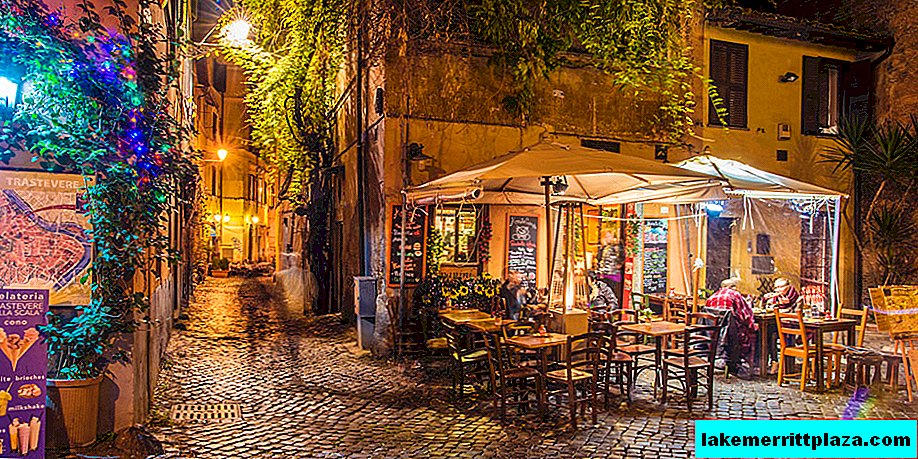Capitoline museums will be interesting to lovers of Roman history. The collection is awesome. The buildings were designed by Michelangelo himself and convey all the greatness and style of the Baroque era. It is better to visit museums in the afternoon, when there are not many who want to. Moreover, the exhibits are more expressive in the rays of the setting sun.

Senators Palace from Capitol Square
Capitoline Hill is not high, and the rise to it is almost imperceptible. Upstairs, along the edges of Capitol Square, designed by Michelangelo Buonarroti, there are 3 palaces:
- Senatorial (Palazzo Senatorio - Palazzo Senatorio),
- Conservatives (Palazzo dei Conservatori - Palazzo dei Conservatory),
- New Palace (Palazzo Nuovo - Palazzo Nuovo).
In the days of the Roman Republic, the Temple of Jupiter stood on this place, the walls and foundation of which can be seen under the Conservatives' palace. Today, this monumental complex of palaces, as well as the nearby Palazzo Cafarelli-Clementino, are home to the oldest museum collection in Rome and the oldest public museum in the world - the Capitol Museums (Musei Capitolini).
The Capitoline Complex was founded by Pope Sixtus IV in 1471. The pontiff gave the city a collection of antique bronze sculptures. Among them was the legendary she-wolf who nurtured babies - Romulus and Remus. In the 18th century, Pope Benedict XIV added an art gallery. Subsequent successors further expanded the collection: replenished with archaeological finds, exhibits from the Vatican.

Capitol Square and Cordonate Staircase
The Capitoline Square with its three palaces and the staircase of the Cordonate was designed by the great Michelangelo in the 16th century. In the XVII century the ensemble was built. And in 1734 the Capitoline Museums were opened for them in free access.
On Capitol Square, attention is immediately drawn to the powerful equestrian statue of Marcus Aurelius. The monument is ancient, created in the II century. True, a bronze copy of it is now installed on the street, and a valuable original is stored in the New Palace, in the hall of Marcus Aurelius.
Senators Palace

View of the Palace of the Senators from Vittoriano
The Palazzo Senatorio today hosts a city council. The exposition of the Capitoline Museums is located in the antique lower part of the palace.
Palace of the Conservatory

The Palazzo dei Conservatori

Capitoline she-wolf (lat.Lupa Capitolina) (XIII century A.D.), the work of the sculptor Antonio del Pollayolo
The Conservatory Palace is given over to works of ancient culture and the Capitoline Pinacoteca art gallery.
On the ground floor are presented: collections of Greek and Etruscan vases, sculptures and sarcophagi, antique mosaics, samples of ancient Roman painting, artifacts from the temple of Jupiter. Famous exhibits: Capitoline she-wolf; Colossus of Constantine; Capitoline Brutus; A boy pulling a splinter; statues of Urban VIII and Innocent X; Hercules from the Bull Forum; Head of jellyfish; Esquiline Venus; Artemis.
In the courtyard are stored the elements of a huge statue of Emperor Constantine: head, brush, fragments of the leg. It is hard to imagine the natural size of a broken colossus. The height of one of his heads is 2.5 meters!
The art gallery is located on the second floor, where works by Italian artists such as Titian, Tintoretto, Caravaggio, Guido Reni and others are presented.
Nuovo Palace

Palazzo Nuovo

"Dying Gall" - marble Roman copy from the Pergamon original, photo winninator
Nuovo Palace was built like the Conservatory Palace, located opposite, and was intended specifically for the museum. In its long galleries and atrium you can see the richest collection of antique Greek and Roman sculptures. The most significant of them are: a collection of busts of 65 Roman emperors around the statue of seated Elena; Dying gall; Venus Capitoline (Roman copy); The wounded Amazon. In the courtyard is the Marforia Fountain.

In the Palazzo Nuovo Palace, photo by Richard Mortel
From the underpass between the palaces you can go to the open gallery. From there, a stunning view of the Imperial Forums.
Cafarelli-Clementino Palace
The Palazzo Caffarelli-Clementino hosts temporary exhibitions and collections of numismatists: rare coins, gems, orders and medals.
Museums Opening Hours
Open daily from 09:00 to 19:30
December 24 and 31 from 9:30 to 14:00.
January 1, May 1, December 25 - closed.
Tickets
Complex ticket - € 15.00 (New Palace, palaces of Senators, Conservatives, Cafarelli-Clementino and Tabularia);
preferential - € 13.00.
How to get there
Capitoline Museums are within walking distance of the Colosseum, the Roman Forum and Venice Square.
You can take metro line B to Colosseo Station;
by bus: 30, 51, 81, 83, 85, 87, 118, 160, 170, 628, 810 - to Ara Coeli-Piazza Venezia;
by tram 8 to the final stop of Venezia.
How do I save on hotels?
Everything is very simple - look not only at the booking. I prefer the search engine RoomGuru. He is looking for discounts at the same time on Booking and on 70 other booking sites.








